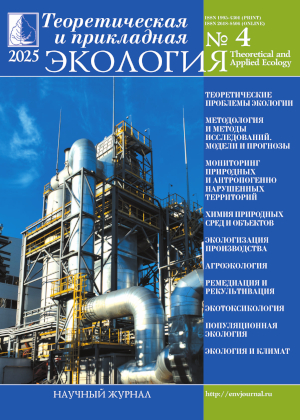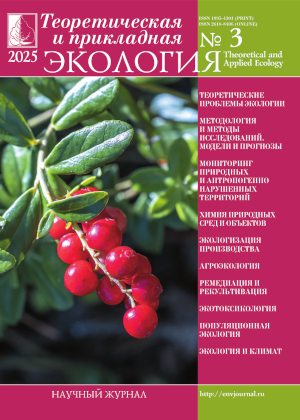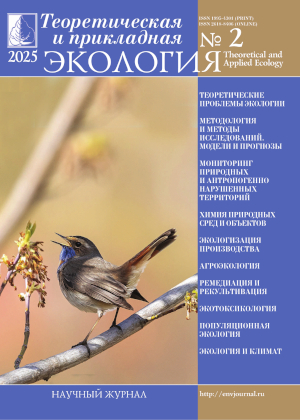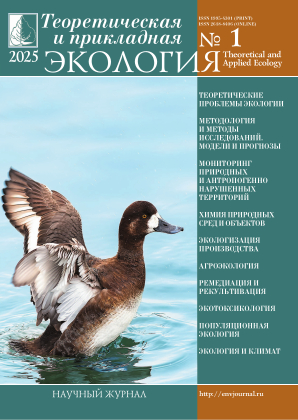 ISSN 1995-4301
ISSN 1995-4301(Print)
ISSN 2618-8406
(Online)
Online version of the journal
|
Potentially fertile soil obtaining during the rehabilitation of accumulated environmental damage sites |
||||
| A.V. Koshelev, E.I. Tikhomirova, O.V. Atamanova, V.F. Golovkov | ||||
| Section: Remediation and rehabilitation |
||||
| This article examines a methodology for the rehabilitation of accumulated environmental damage sites (AEDS), based on the conversion of disturbed and contaminated lands into potentially fertile soils using bulk waste (overburden, decontaminated soils, drill cuttings, oil-contaminated soils, and landfill soils) in combination with various technological methods, including thermal decontamination, leaching, and treatment with humic preparations and natural adsorbents. The main conceptual principles of this methodology are based on a combination of organizational and technical techniques (methods). These techniques enable the conversion of disturbed and contaminated lands into potentially fertile soils, and the conversion of waste into secondary raw materials. The objective of this study was to develop a concept for the rehabilitation of AEDS based on the conversion of disturbed and contaminated lands, as well as waste, into potentially fertile soil (PFS) using an innovative technology that takes into account the particle size distribution, chemical contamination, cation exchange capacity, humus content, and the safety (hazard class 5) of the resulting substrate. The technology for producing conditionally fertile soils was examined using the example of a model problem of converting inert coarse waste of hazard class 5 into potentially fertile soil suitable for reclamation. The experimental studies showed that drill cuttings, a large-tonnage industrial waste, are of particular interest as an ameliorant. The resulting complex composition of humic-mineral ameliorant and sand meets the requirements for PFS, as drill cuttings provided 10% of the fine fraction, the humic preparation met the humification standard, and together, the humic preparation and drill cuttings provided a sufficient cation exchange capacity of the soil – 17 mg-eq/100 g. Changes in soil phytotoxicity were studied depending on the reclamation dose and time. A sharp reduction in phytotoxicity was achieved with a reclamation dose of 0.8 kg/m2. Samples of man-made soil with initial lead, zinc, and copper contents were studied. The extraction of lead, copper, and zinc by dynamic leaching ranged from 80 to 95%, demonstrating the potential of the proposed soil remediation method. | ||||
| Keywords: accumulated environmental damage site, methodology, rehabilitation, reclamation, humic preparations, bentonite, glauconite |
||||
   |
||||
| Article published in number 4 for 2025 DOI: 10.25750/1995-4301-2025-4-179-190 |
||||
|
||||
Characteristics of the basic elements in the urban ecosystem ecological framework and their status assessment |
||||
| Е.V. Yurkina, G.G. Romanov | ||||
| Section: Methodology and research methods. Models and forecasts |
||||
| In the context of an crisis, the value of the preserved environment as a factor in the stabilization of natural processes will steadily increase. The general tension in urban environmental problems formed based on the location of the settlement, the nature of the industrial impact, the development of the green infrastructure that is part of the ecological framework (EF). In the municipality space, the EF must occupy an area of at least 25% of the territory. The interrelationships of the city and nature in the North conditions have a number of features that distinguish them from cities of other natural zones. Climatic and soil factors, hydrology and relief are among them. High development of industry and low resistance of landscapes to anthropogenic loads characterize urban ecosystems of these territories. Environmental problems of cities will become less acute if a reliable EF is created. We consider the urban EF as a set of ecologically and functionally interconnected territories with vegetation of various types and purposes. The article is devoted to the analysis of the EF basic elements in the Syktyvkar municipality and their status assessment. To form a full-fledged EF in the territory of the municipality under consideration, it is necessary to massively renovate the green spaces in the residential zone, give legal status to urban protected natural areas and form a system of transit “green corridors” connecting them into a single system. | ||||
| Keywords: ecological framework, green infrastructure, urban protected areas, recreational landscapes, urban biota |
||||
 |
||||
| Article published in number 4 for 2025 DOI: 10.25750/1995-4301-2025-4-058-065 |
||||
|
||||
Identification of genetic determinants of antibiotic microbial resistance in areas affected by biogenic pollution |
||||
| V.A. Kozvonin, N.V. Syrchina, L.V. Pilip, Т.I. Kutyavina, T. Ya. Ashikhmina, E.V. Koledaeva, S.A. Kuklin, T.S. Kokareva, A.N. Chastoedova, M.A. Vinogradova, A.A. Tanatarova, A.M. Grigoreva, S.P. Mikheeva | ||||
| Section: Agroecology |
||||
| Antibiotic resistance (ABR) in microorganisms (MO) is one of the most pressing issues in modern healthcare. The emergence and spread of antibiotic-resistant strains of MO in various environments, including natural environments, is currently being actively studied. A comprehensive assessment of ABR is impossible without the use of molecular genetic methods. However, while a significant number of specialized reagent kits, materials, and equipment are available for isolating total MO DNA from environmental samples, ready-to-use, out-of-the-box test systems for amplifying DNA sequences are virtually nonexistent. However, commercial kits have been developed and are widely used to amplify the DNA of antibiotic-resistant MO strains in biological samples collected from humans (patients). The aim of this study was to evaluate the feasibility of adapting test systems used to detect ABR genes in MO isolated from humans to detect ABR genes in MO DNA samples isolated from environmental sources. The study found that laboratory kits manufactured by Litekh can be used to detect ABR genes in MO DNA samples obtained from soils and manure runoff. These laboratory kits detected resistance genes to tetracyclines (TetM), macrolides (ErmB, Mef), and cephalosporins (blaOXA10) in the soil and manure samples analyzed. Specific antibiotic resistance genes were detected in study sites experiencing biogenic pollution and were absent from control sites. The obtained results confirm a high degree of commonality between the ABR genes in MO isolated from OS and clinical MO strains isolated from humans. The identification of identical genetic determinants of antibiotic resistance (TetM, ErmB, Mef, blaOXA10) may indicate the existence of a single pool of ABR genes that moves between different ecological niches, the data indicate significant contamination of the environment with antibiotic-resistant microorganisms in areas where livestock by-products are located and the need to organize a monitoring system for this phenomenon at these sites. | ||||
| Keywords: antibiotic resistance, microorganisms, environment, DNA, polymerase chain reaction, resistance genes, monitoring, molecular diagnostics |
||||
| Article published in number 4 for 2025 DOI: 10.25750/1995-4301-2025-4-160-168 |
||||
|
||||
Soil microbiome in Technosol on gypsum-containing chemical production waste |
||||
| I.G. Shirokikh, E.V. Dabakh, L.V. Kondakova, N.A. Bokov, T.Ya. Ashikhmina | ||||
| Section: Population ecology |
||||
The soil microbiome plays an important role in the processes of soil formation and functioning of the soil. The role of the microbiome is especially significant at the initial stages of soil formation in man-made landscapes on uncharacteristic rocks, such as gypsum-containing waste (GCW) from chemical production. The aim of the study was to evaluate the structure and composition of the algoflora and the prokaryotic component of the microbial community in young soil formed during self-healing of the GCW landfill of a chemical enterprise. The object of the study was an embryozem formed in the southern taiga subzone of the European Northeast in a self-growing open GCW storage facility for more than 20 years, with soil on aluminosilicate rock – floodplain alluvium under a grass meadow adjacent to the waste storage area as a conditional background. 16 species of microphototrophs were detected in the soil of the background site by direct microscopy of soil, fouling glasses and cup cultures, and 19 species of microphototrophs were detected in the embryozem. The species diversity is represented by cyanobacteria, green and diatoms. Representatives of 12 bacterial and 1 archaeal phylum were identified in the prokaryotic component of the embryozem community (based on the diversity of 16S rRNA gene sequences). The phylum – level dominants in the embryozem and background soil communities were the same: Proteobacteria (on average 28.6%) and Actinobacteria (17.4%). Verrucomicrobia, Acidobacteria, and Bacteroidetes accounted for an average of 3–6% of the total number of taxa. The microbiome of the embryo differed from the mature soil of the background site by the presence of minor representatives of Chloroflexi (1%), Cyanobacteria (0.3–0.4%) and Firmicutes (0.1%). Studying the composition and structure of the soil microbiome at the first stages of pedogenesis provided valuable information for understanding the factors contributing to soil formation, as well as for optimizing reclamation methods. |
||||
| Keywords: Technosols, prokaryotes, algocyanoflora, sequencing of amplicon libraries of the 16S rRNA gene |
||||
    |
||||
| Article published in number 4 for 2025 DOI: 10.25750/1995-4301-2025-4-200-211 |
||||
|
||||
Lead concentrations in organs and tissues of the wild reindeer (Rangifer tarandus, Linnaeus, 1758) in the north of Krasnoyarsk Region |
||||
| P.V. Kochkarev, M.A. Perevozchikova, A.A. Sergeev, V.V. Shiryaev | ||||
| Section: Chemistry of natural environments and objects |
||||
| Lead (Pb) is a hazardous toxicant. Elevated lead content in the environment can have a significantly affect health, reproductive success and survival of wild animals. The studies determined lead concentrations in forage plants, skeletal muscles, liver, kidneys and mammary glands of adult female wild reindeer (Rangifer tarandus, Linnaeus, 1758) in the background and contaminated areas of Russian Krasnoyarsk region during the feeding period of young animals. ANOVA-tests revealed a significant relationship (p=0.00) of the territorial factor and lead concentration in the liver, kidneys and skeletal muscles of female reindeer. The lead content in the body of reindeer in the study area is comparable with similar data from the subarctic regions of Eurasia and North America and is significantly (p<0.05) higher in contaminated sites in all indicator organs and tissues, compared to background areas. The reduced liver lead content of lactating females compared to non-lactating females in contaminated areas may indicate endogenous Pb transfer to the offspring during pregnancy and lactation. The main source of lead intake by reindeer is probably willows and sedges, in particular Salix lanata and Carex arctisibirica, which concentrate this metal in the above-ground phytomass and are important forage for reindeer during the active vegetation period. The meat and internal organs of half of the wild reindeer females that fed at contaminated pastures in the summer–autumn period are not suitable for human consumption. The results make a new contribution to the study of pollutant effect on terrestrial biota in subarctic regions and highlight the potential for combined use of game management and ecotoxicology methods for future efforts in biomonitoring, conservation and management of economically important wild animal species. | ||||
| Keywords: Rangifer tarandus, wild reindeer, females, lead, lactation, mammary gland, liver, kidneys, muscles, pollution |
||||
| Link | ||||
| Article published in number 4 for 2025 DOI: 10.25750/1995-4301-2025-4-094-106 |
||||
|
||||
Heterologous rhamnolipid producers based on Acetobacter aceti AlC1824 obtaining |
||||
| M.N. Baramzin, S.G. Litvinets | ||||
| Section: Chemistry of natural environments and objects |
||||
| Rhamnolipids solubilize oil contaminants in soils, making them more accessible for decomposition by soil microorganisms. Unlike chemical surfactants, rhamnolipids are environmentally friendly. The aim of this work is to obtain heterologous rhamnolipid producers based on Acetobacter aceti AlC1824 using an artificial promoter and optimize the producer cultivation conditions. This approach will avoid the use of highly effective biosurfactants of the opportunistic Pseudomonas aeruginosa species as a rhamnolipid producer, which can be used for soil bioremediation. The rhlAB gene cluster was amplified from the Pseudomonas aeruginosa B-6643 genome by polymerase chain reaction. A construct consisting of the rhlAB gene cluster and an artificial promoter was inserted into the p-AlT2 vector. The insert was introduced into Acetobacter aceti AlC1824 cells by calcium transformation. A total of 20 transformants were selected by blue-white selection. The target insert was detected in 7 transformants by polymerase chain reaction. The indicator test revealed a characteristic precipitate in two transformants: A4 and A8. Glucose, mannitol and glycerol were used as substrates. Suitable nitrogen and carbon sources were determined: peptone and mannitol, respectively. We found that the overall optimal pH of the medium was 5; the optimal cultivation temperature was 30 оC for A4 and 25 оC for A8. The amount of rhamnolipids formed by the above in optimal conditions is 139.3±20.1 mg/mL for transformant A4 and 13.0±1.0 mg/mL for transformant A8. The high washrhamnolipid emulsifying activity of heterologous producers in relation to crude oil has been experimentally demonstrated: EI24 for A4 was 93,9±1,5%, and for A8 – 96,7±1,5%. | ||||
| Keywords: rhamnolipids, heterologous expression, biosurfactants, productivity optimization, acetobacter, pseudomonads |
||||
| Article published in number 4 for 2025 DOI: 10.25750/1995-4301-2025-4-107-113 |
||||
|
||||
Methods of restoring lands disturbed by drill cuttings disposal: current approaches review |
||||
| A.A. Perevoshchikova, R.D. Perevoshchikov, A.A. Surkov, L.V. Rudakova | ||||
| Section: Theoretical problems of ecology |
||||
| This review explores the issue of surface placement of drill cuttings waste (DC) and its environmental consequences. Special focus is given to the DC detrimental effects on soils and methods for disturbed lands restoring. The DC contains oil and oil products (up to 7%), mineral salts (up to 16.8%), and heavy metal compounds (up to 6%). The risk of environmental pollution arises from the low-hazard nature of the DC components. However, the water-soluble salts ions (chlorides, sulfates, sodium) can greatly affect the environment, while petroleum products and heavy metals have less effect. DC pollution leads to disturbance of the ecological balance in the soil biocenosis, vegetation depression and landscape transformation. The challenge of restoring lands affected by DC disposal is the most urgent for Western Siberia. Therefore, this review examines various approaches to such lands restoration. The methods involve the mineral additives as well as humic-mineral ameliorants applying, leveling layers and sowing perennial crop seeds, the production of man-made soil followed by the phytomeliorant plants sowing, sorbents and geotubes application, as well as biological methods implementation. The drawbacks of the above mentioned approaches include economic inefficiency and transport inaccessibility in the supply of certain materials and resources. However, the creation of artificial soils through biological methods in conjunction with mineral fertilizers and sandy soil facilitates the initiation of soil-forming processes, ultimately alleviating the anthropogenic burden on the environment and restoring disturbed lands and ecosystems with minimal financial cost. Thus, DC can be a mineral soil-forming rock for the development of “young” soils and the formation of stable phytocenoses, since it contains trace elements necessary for plants, and is based on an aluminosilicate material on which most natural soils are formed. | ||||
| Keywords: oil production, drilling fluid waste, disturbed areas, reclamation, soil formation |
||||
   |
||||
| Article published in number 4 for 2025 DOI: 10.25750/1995-4301-2025-4-018-027 |
||||
|
||||
Application of magnetite nanoparticles for tungsten extraction from aqueous solutions |
||||
| N.V. Podvalnaya, Yu.A. Bakhteeva, M.S. Filinkova, I.V. Medvedeva, V.T. Surikov, I.V. Byzov | ||||
| Section: Ecologization of industry |
||||
| Magnetite nanoparticles Fe3O4 synthesized by chemical precipitation were used for the magnetic extraction of tungsten(VI) ions (CW0=0.5 mg/L) from aqueous solutions. At the first stage, tungsten ions were sorbed by magnetite particles. Then the sorbent was removed from aqueous solutions by magnetic filtration. We studied the pH of the solution, Fe3O4 concentration, and the contact time between the target ions and the added MNP effect on the efficiency of tungsten ions magnetic extraction from aqueous solutions. The tungsten removal was strongly dependent on pH of the aqueous solution. The magnetic extraction maximum value (0.0005 mg/L) was observed at pH 5, 20 mg/L magnetite concentration and within 1 hour contact time. The maximum adsorption capacity of Fe3O4 was 270 mg/g at pH 5. The obtained value of adsorption capacity is 6 times higher than that known in the literature for other sorbents. This is probably due to the MNP large specific surface area. It was shown that tNaCl addition did not significantly change the efficiency of tungsten ions extraction, as well as Na2SO4 presence in aqueous solution the extraction efficiency. These results can be explained | ||||
| Keywords: magnetite, tungsten ions, water purification, adsorption, magnetic separation |
||||
| Article published in number 4 for 2025 DOI: 10.25750/1995-4301-2025-4-114-122 |
||||
|
||||
Changes in the biomass of ground vegetation after clear-cuts of coniferous-deciduous stands (middle taiga, Komi Republic) |
||||
| D.A. Severgina, S.R. Krasikov, A.F. Osipov, A.A. Dymov | ||||
| Section: Monitoring of natural and anthropogenically disturbed areas |
||||
| Ground vegetation is an important indicator of the environment status and perform a number of significant ecosystem functions, including in the process of reforestation. However, the dynamics of the woody vegetation biomass state is of the main attention, while the lower tiers often remain underestimated. The article presents the analysis of changes in the aboveground biomass of ground vegetation in the first years after clear-cutting of a coniferous-deciduous stand (blueberry-green moss type). We found an increase in the average aboveground biomass of ground vegetation on slightly disturbed skidding trails from 155±32 g/m2 to 222±38 g/m2 in the first year after logging and up to 799±159 g/m2 in the third year after logging. Structural changes in the contribution of individual components to the total reserves caused by active overgrowing of the clearing with herbaceous plants (cereals) and a decrease in the share of sciophytes. The number of logging equipment passes does not have a reliable effect on the ground vegetation biomass. However, we revealed the differences in the mass and structure of the ground vegetation in the ruts and intertrack spaces of the hauling routes. The data obtained expand the existing information on the ecological role of lower-tier plants in clearings. It will find application in characterizing the response of the cycle of substances and assessing the restoration of taiga forests after clear-cutting, including under changing climate conditions. | ||||
| Keywords: middle taiga, biomass, clear-cutting, ground vegetation, mixed coniferous-deciduous stand |
||||
| Article published in number 4 for 2025 DOI: 10.25750/1995-4301-2025-4-076-082 |
||||
|
||||
Cultivation patterns of microscopic algae under carbon dioxide biofixation conditions |
||||
| A.S. Solovyova, E.S. Belik, L.V. Rudakova | ||||
| Section: Agroecology |
||||
| The decarbonization strategy implemented in enterprises of the Russian Federation necessitates the development and scientific validation of appropriate technological solutions. One promising approach to utilising carbon dioxide emissions is the microalgae cultivation. This approach is based on the ability of some microalgae species to actively increase their biomass and sequester carbon dioxide when the the above gas content in the air increases. The article presents the results of experimental studies on cultivation of four consortia of microscopic algae in a gas medium with increased carbon dioxide content. These consortia were grown in the laboratory and isolated from the environment. Microalgae were cultivated under continuous CO2 infusion, gradually increasing the concentration from 5 to 15%. The experiment yielded CO2 concentrations that favoured rapid biomass growth for each of the four cultures tested. The highest average growth rates were observed: at a CO2 concentration of 5% in a culture isolated from a eutrophic freshwater pond containing the green microalgae of various genera, including Chlorella spp. (0.01230±0.00015 units of optical density per day), and at a CO2 concentration of 10% in a culture isolated from conifer lichens consisting of the microalga Chlorella spp. and filamentous fungi (0.0157±0.0007 units of optical density per day). The number of cells in the culture of microalgae isolated from a eutrophic freshwater pond grew particularly fast in the presence of 5% carbon dioxide. After 66 days, the optical density of the culture had increased by more than 9 times. In the remaining cultures, after 102 days, in an atmosphere with carbon dioxide content ranging from 5% to 15%, the optical density increased 2 to 3 times. The experimental results confirmed the effectiveness of microalgae for carbon dioxide utilisation. | ||||
| Keywords: carbon dioxide utilisation, biofixation, microalgae, Chlorella |
||||
| Article published in number 4 for 2025 DOI: 10.25750/1995-4301-2025-4-169-178 |
||||
|
Pages:
|
36, Moskovskya street, Kirov, 610000, Editorial Board "Theoretical and Applied Ecology." Phone/fax: (8332) 37-02-77 e-mail: envjournal@vyatsu.ru The journal was founded in 2007 |
||||||




 Select viewing options
Select viewing options